Watch This Bee Build Her Bee-jeweled Nest
A new type of bee is buzzing through California’s orchards. And researchers are hoping that the iridescent, greenish insect may help provide a more efficient way to pollinate nuts and fruits in an era when traditional honeybees have struggled.
Unlike honeybees, blue orchard bees don’t sting humans. And instead of building large colonies with thousands of worker bees caring for eggs laid by a queen bee, female blue orchard bees work alone to build their nests and stock them with food. They’re solitary bees, like most of the 4,000 species of bees in North America.
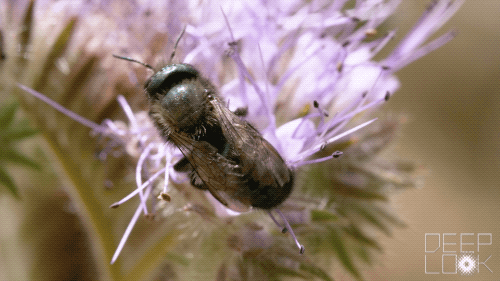
Blue orchard bees, which are native to the United States, are of increasing interest to scientists, government agencies and farmers for their ability to pollinate almonds, sweet cherries and other tree fruits more efficiently than honeybees.
“This is, I think, the moment for these bees to shine,” said entomologist Natalie Boyle, who studies blue orchard bees at the United States Department of Agriculture in Logan, Utah.
Boyle works with almond growers in California, whose crop is worth $5.2 billion a year and who rely heavily on honeybees to pollinate their orchards every February. Research has found that 400 female blue orchard bees are as effective at pollinating almonds as the more than 10,000 bees in a honeybee hive, said Boyle.
“So for California almonds, they typically use two honeybee hives per acre,” she said. “The strategy that we’ve been trying to promote is instead of relying on two hives per acre, why don’t we bring down the stocking rate to one hive per acre plus 400 female blue orchard bees per acre?”
Between 40 and 50 percent of honeybee colonies die each year around the country, according to the yearly National Honey Bee Survey, carried out by universities with the sponsorship of the USDA and the California Almond Board, among others.
“A lot of beekeepers’ operations have been under a lot of duress for a multitude of factors: moving stress, pesticide exposure, varroa mites, viruses,” said Boyle. “You name it, these bees have had to go through it.”
Finding other bees that could work side by side with honeybees could offer what she calls “pollination insurance.”
“Maybe we don’t want to put all of our eggs in this one pollination basket,” she said, referring to honeybees, “and we can diversify the suite of pollinators that are available to us for improved food security.”
So researchers around the country are trying to learn everything they can about blue orchard bees’ ability to build intricate nests and pollinate almond and fruit orchards.
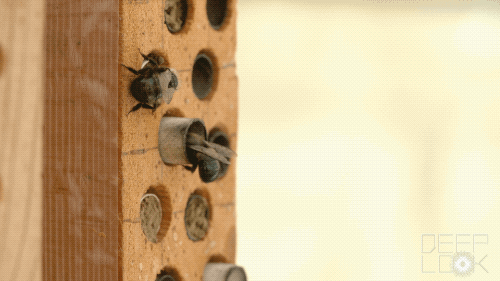
Inside a 10-foot-by-10-foot mesh cage at the UC Davis bee research facility, Ph.D. student Clara Stuligross stared at a block of wood with holes in it, each hole the width of a pencil and about 6 inches long. She had slipped a white paper straw in each one. All day long throughout May and June, she kept a close watch on the bees – all females – as they climbed in and flew out of the straws to build their nests.
“In the wild they would nest in maybe beetle burrows or hollow twigs or things like that,” said Stuligross. “But they take really well to these human-made drill holes in blocks. And we put the straws in just so we can take the straw out and look and monitor their nesting progression.”
Near the wooden nest block, Stuligross had dug a hole in the dirt and mixed in some water. Blue orchard bees are masons that use mud to build their nests. They scrape the wet earth and form a ball of mud with two huge pincerlike tools on their face called mandibles. Then they carry the mud into their nest, in this case a straw.
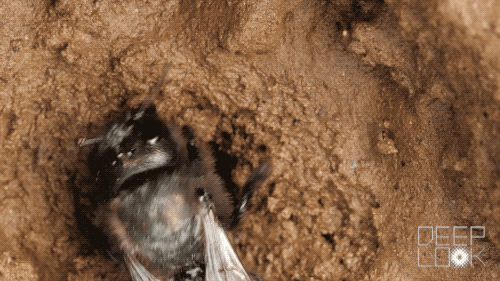
Stuligross painted each bee so she could keep track of them.
“I need to see which mother bee is associated with which offspring,” she said. “So I need to know exactly which hole each of them is nesting in every day.”
Stuligross wants to figure out how successful the bees are at egg-laying, given the amount of insecticide she sprayed in the cage and the number of flowers she planted for them.
Inside its nest, the bee builds a wall of mud. Then it climbs out and flies from flower to flower drinking nectar and gathering pollen. Stuligross planted nutritious purple flowers called lacy phacelia for the bees. Each flower has several long anthers sticking out; the tip of each one is covered in purple pollen. The bee grabs the anthers with its legs and rubs the pollen onto hairs on its abdomen called scopa, which make them really good pollinators.
“Their bellies are very hairy,” said Stuligross, “and the pollen will stick to their bellies once they scrape it off the flower.”
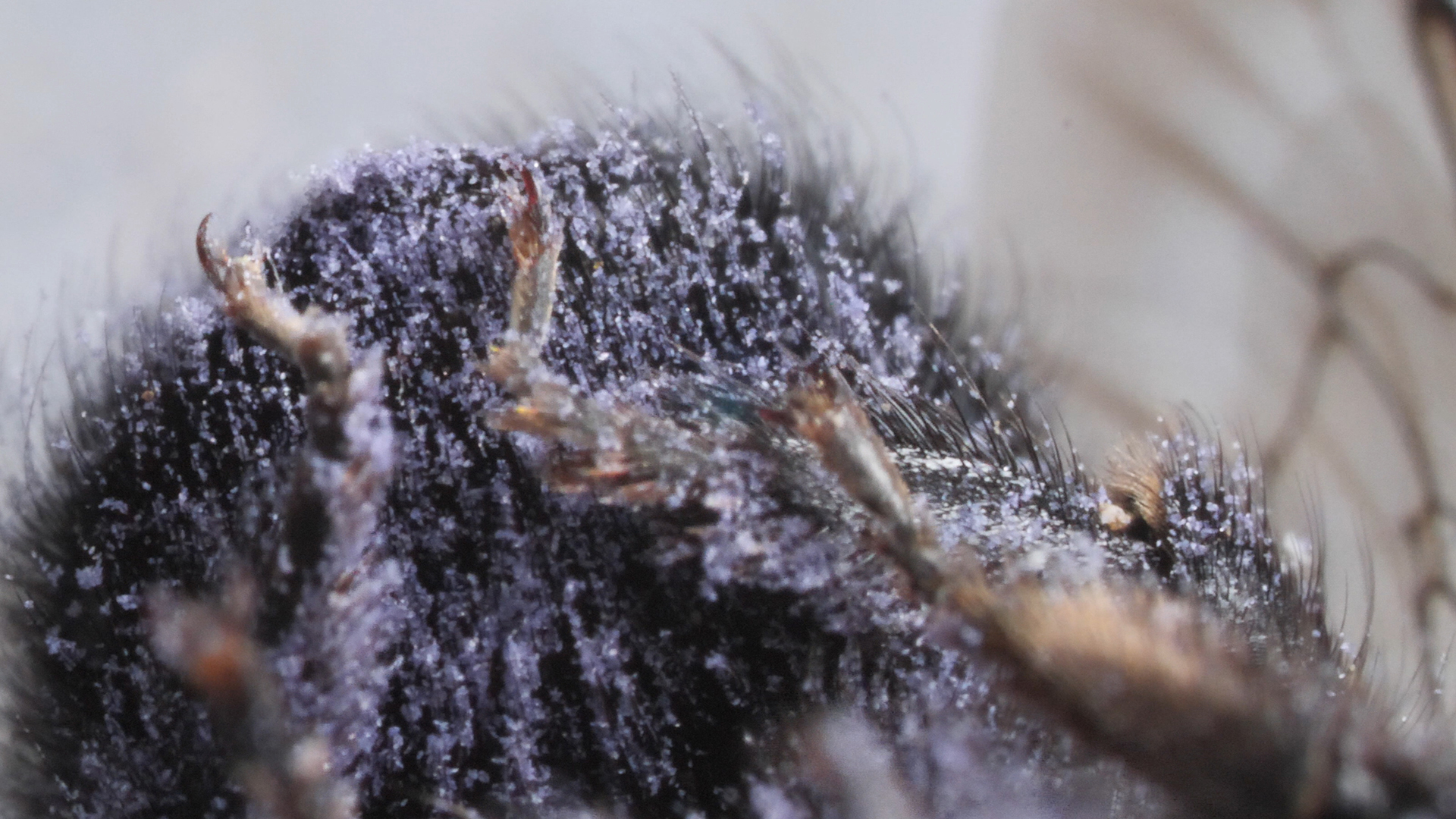
When they land on another flower, the pollen from the first flower rubs off onto the second flower as they vigorously forage.
“She’s up all over that blossom. I mean she’s landing on top of it, she’s crawling between the anthers, over the top of the pistil,” said Boyle. “It’s really entertaining to watch.”
When a bee climbs back into her nest, she scrapes the remaining pollen off her body and mixes it with a little regurgitated nectar to make a pollen ball next to the mud wall. On this ball she lays a single egg.
She repeats this several times in her narrow nest until she has made seven or eight little chambers separated by mud walls. Each chamber holds an egg in it, growing on a ball of pollen called a pollen provision. When she’s done, the bee seals the nest with more mud that she smoothes out with her legs and mandibles.
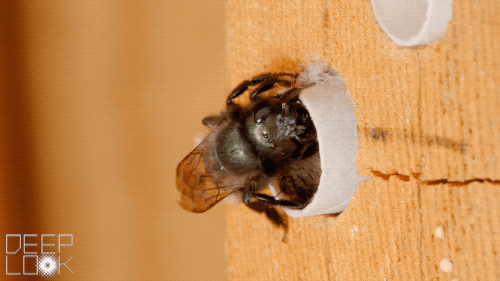
Stuligross carefully sliced through one of the paper straws to reveal the nest inside. The cross-section of the nest showed the bee’s incredible craftsmanship. The mud walls and purple pollen balls arranged sequentially made the nest look like a piece of jewelry. A female blue orchard bee is only active for four to six weeks in the spring, during which she mates and then lays about 15 eggs in two nests. At the end of this reproductive season, she dies.
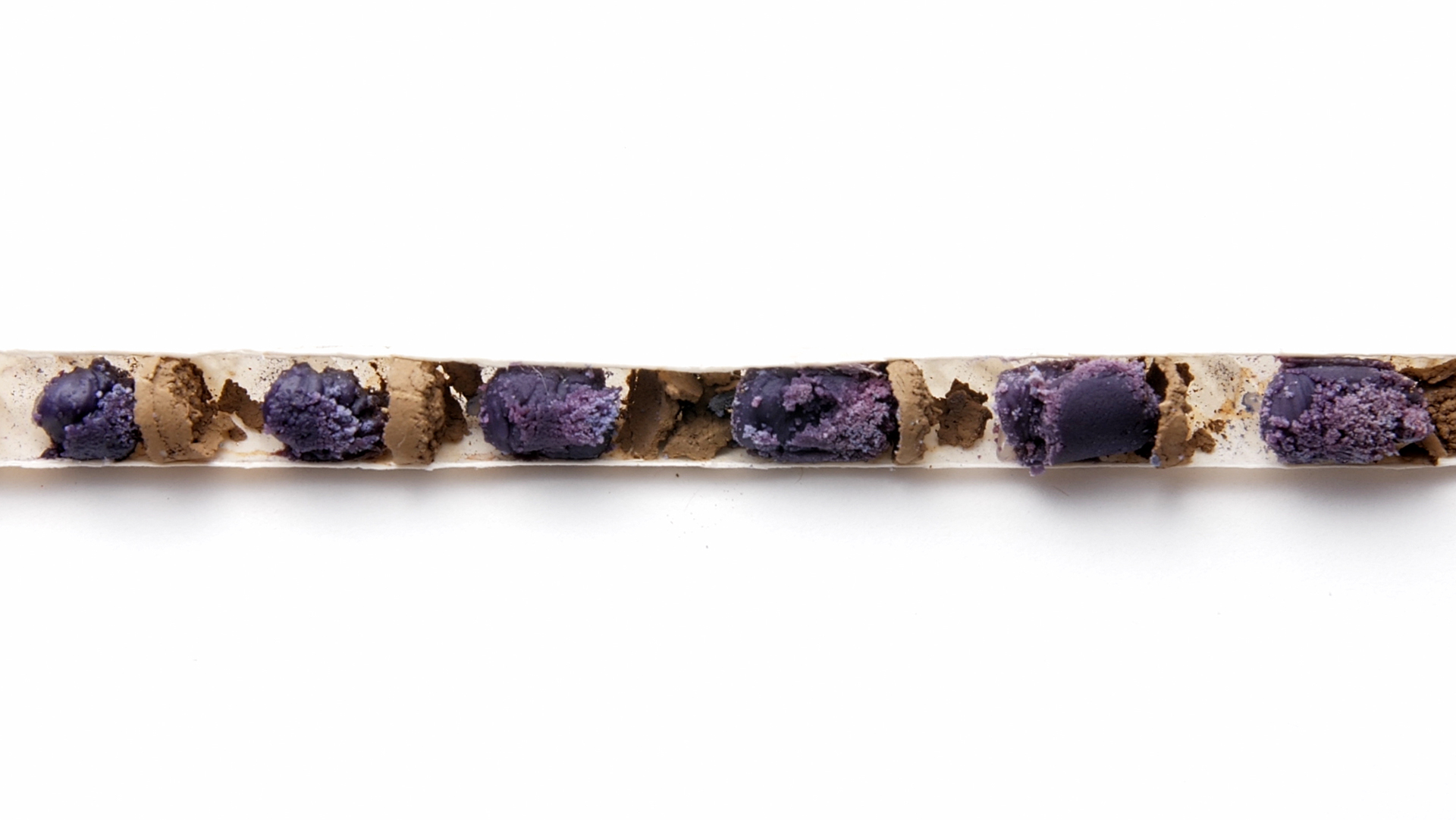
When the eggs hatch inside the nest, a white larva in each chamber spends three weeks fattening up on its pollen provision, the purple lunchbox its mother bee packed for it.
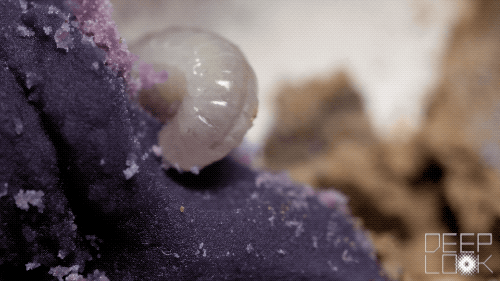
Still in the safety of the nest, the well-fed larva spins a cocoon inside which it grows into a pupa and then an adult. The following spring, the adult bee chews its way out.
These portable nests make it easy for scientists and growers to move the bees in and out of orchards. They can open up the nests, remove the cocoons and keep them in a temperature-controlled incubator until an orchard is in bloom, Boyle explained.
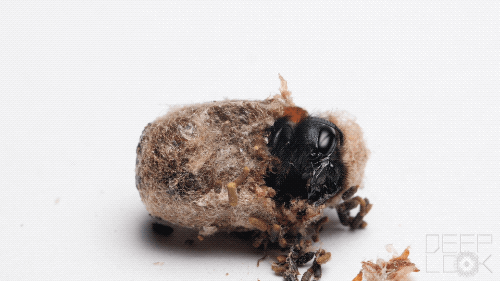
Blue orchard bees are particularly good at pollinating almonds and tree fruits like cherries and apples because they love foraging in their flowers or, as Boyle puts it, the bee “has a high fidelity to orchard crops.”
They’re particularly well-suited to pollinate almonds, which are in bloom in February, when it’s chilly in California’s Central Valley, because they will fly around and forage at a cooler temperature than honeybees.
Currently, some California growers are using blue orchard bees in their almond orchards, and sweet cherry farmers in California and Washington state are also bringing them onto their fields, said Boyle.
But challenges remain.
Blue orchard bees reproduce slowly. While a queen honeybee can lay 500 eggs a day, a blue orchard bee lays only about 15 eggs in her entire lifetime of one year, said Boyle. So there just aren’t that many blue orchard bees around, which makes them expensive for growers, at about $1.50 per female.
If an almond grower, for example, wanted to replace one honeybee hive with 400 blue orchard bees, that would cost $600 as opposed to a $200 honeybee hive rental fee. And that’s if the blue orchard bees were available at all.
“The bulk of the supply right now is coming from wild-trapped populations of blue orchard bees, often times on federal land, which isn’t even legal,” said Boyle.
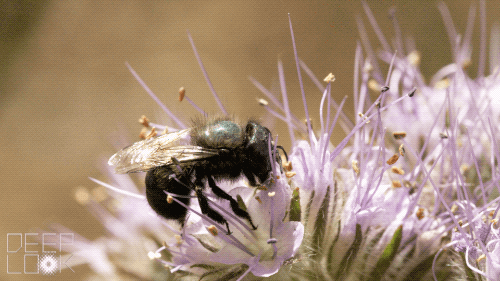
Recently, the largest almond grower in the world ended its blue orchard bee reproduction experiments in California.
“I just don’t think they found it to be profitable,” said Boyle, who as a USDA researcher worked with the company, Wonderful Orchards, on its blue orchard bee efforts.
Solitary bees that they are, blue orchard bees tend to go off on their own. They’re not like honeybees, which return to the hive each day. So there’s no way to guarantee that a farmer will end up with nests that contain a similar number of bees than they originally released on their land. This forces them to buy new bees each year, an expensive proposition.
Scientists are trying to figure out how to keep these bees on the land, attracting them with abundant food, for example. Boyle and her colleagues have made some progress. For the third year in a row, they have released 275 blue orchard bees per acre into tart cherry orchards in Utah, and retrieved a similar number of bees at the end of the season.
“We think these tart cherries that we have them in are an excellent target crop for blue orchard bees,” said Boyle.
She’s also excited to start research on their use in pear orchards in Washington state.
“In a lot of ways,” said Boyle, “I feel like we’re still working as pioneers for this industry.”